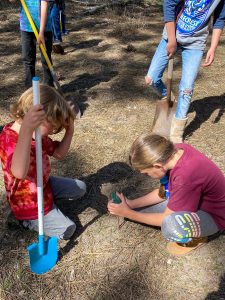Today, let’s talk about worms, a welcome addition to the garden. Here are some of the key benefits of earthworms:
Soil fertility – earthworms improve soil structure and fertility. Their activity adds organic matter to soils and creates binding agents that affect soil aggregation. Their burrows create channels that enhance aeration and water infiltration. This allows plant roots to access oxygen and nutrients more easily, leading to healthier and more productive plant growth.
Nutrient cycling – earthworms consume organic matter such as dead plant material and decomposing organic waste. The resulting worm castings (feces) are rich in nutrients, such as nitrogen, phosphorus, and potassium, making them valuable fertilizers for plants.
Soil aeration – burrowing earthworms loosen compacted soils, allowing for better root penetration and enhancing soil aeration. Increased aeration facilitates the growth of beneficial soil microorganisms, contributing to the nutrient cycling and soil health mentioned above.
Water regulation – earthworm burrows act as conduits for water movement within the soil, draining excess water during periods of heavy rain. These channels also improve soil water-holding capacity during dry periods.
Carbon sequestration – as earthworms consume plant debris and organic waste, carbon is incorporated into their bodies and deposited in the form of stable organic matter (humus) in the soil. This stores carbon, reducing the amount of carbon dioxide in the atmosphere.
Biodiversity support – earthworms serve as a food source for a variety of animals, including birds, mammals, and invertebrates. They also interact with soil microorganisms contributing to the overall interrelated functioning of ecosystems.
However, there are worms, and then there are worms. Earthworms, the soil-dwelling type, are usually Lumbricus rubellis or a close cousin. They burrow as deep as eight to twelve feet below the surface to find moisture, aerating and fertilizing the soil as they go, allowing roots to spread, preventing erosion and making good crumbly soil down deep as well as on top. What’s not to love about these guys?
You can purchase a supply of earthworms, place them on top of the ground (wait until the soil temperature is at least 65 degrees) and they’ll dig their way into the soil in their effort to avoid the light. They’ll be happy and reproduce only if there is adequate organic material in your soil. Baby earthworms emerge from a tiny cocoon the size of a grain of rice. The eggs can be dormant for years, until the soil is rich enough to nourish them.
On the other hand, red worms, or red wigglers, are the worms that live in your compost bin. Red worms are usually Eisenia fetida or a related species. They work their way through kitchen and garden wastes, producing nutrient-rich castings which we happily add to our gardens and house plants. These worms can be purchased and, once established in your compost bin, will reproduce indefinitely if conditions are to their liking.
This science of cultivating worms is known as vermiculture. If you are interested, there are abundant resources available on-line including this blog from San Joaquin Master Gardeners (https://ucanr.edu/blogs/blogcore/postdetail.cfm?postnum=17055) If you are really serious about worms, you’ll have both earthworms working beneath the surface and red wigglers hard at work in your compost bin. Go earthworms!
Sylvia Watterson is a University of California Cooperative Extension Master Gardener of Tuolumne County.

